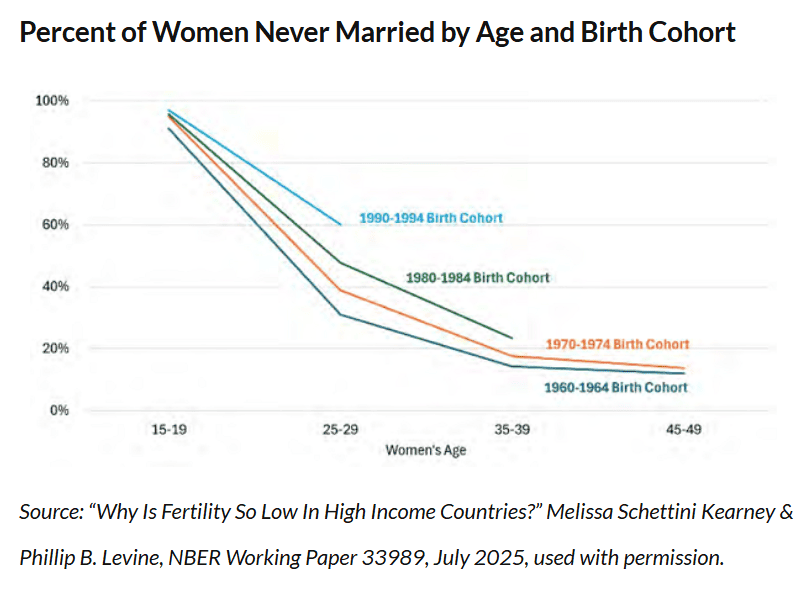Daily Citizen has been tracking the long, slow decline in divorce rates in America, here, here, here and here.
But what if that is not actually good news for marriage and the family? It seems like a counter-intuitive thought, but that is what a family scholar at the Institute for Family Studies (IFS) wants us to consider. She makes an interesting and important point.
First, let’s address two big misunderstandings when it comes to divorce.
Most people assume the risk of divorce for couples marrying today is 50%. It is not. It’s actually about 42%. But as research done by Focus on the Family demonstrates, many couples marrying today have a dramatically lower risk of lifetime divorce because they have made life choices and have advantages that dramatically elevate their risk of building a successful marriage.
The other misunderstanding is that almost nine out of ten people assume the divorce rate is rising in the U.S. but it is not. Divorce has steadily declined from its historic high in 1980, to a 50-year low today.
So, why might this remarkable divorce decline not be good news? Leah Libresco Sargeant, the author of the IFS piece, explains “the story of declining divorce isn’t primarily a story of stronger marriages, but of a failure to make matches in the first place.” She is correct on the decline of marriage.
The U.S. Census Bureau reports (May 2024) that married-couple households made up 47% of all U.S. households in 2022, down from 71% in 1970.
The National Center for Family & Marriage Research (NCFMR) at Bowling Green State University notes the U.S. marriage rate has declined 54% from 1900 to today. That rate peaked in 1920 at 92.3%, almost triple today’s rate.
Pew Research Center reports (2023) a dramatic 4-fold increase since 1980 in never married adults in the U.S., a record high. As of 2021, 25% of 40-year-olds in the United States have never married. This is a dramatic increase from 6% in 1980. While many of these unmarried 40-year-olds are living with a romantic partner, most are not. In 2022, 22% of never-married adults aged 40 to 44 were cohabiting. And 80% of marriages taking place today are preceded by some form of cohabitation. Singleness and cohabitation are the relational growth markets.
Sargeant highlights a trend graph by generational birth cohort from a new and important National Bureau of Economics Research working paper addressing why fertility is so low in high income countries. It’s related to declining marriage rates.

Marriage has been declining sharply for multiple generations. The noted economics paper explains “marriage and fertility remain tightly linked, even in high-income countries today.” The two authors, Melissa Schettini Kearney and Phillip B. Levine, note, “The data reveal that as a descriptive matter, the decline in fertility in high-income countries corresponds to a decline in marriage.”
So, when the population of people marrying declines, so does the pool of people who could possibly get divorced. Sargeant asks, “So, what would represent genuinely encouraging news about marriage in America?”
Her answer, “It would help to see the divorce rate decline while marriage rates rise. Then we might have reason to believe that people were getting better at being married, rather than that our culture was convincing people to give up on marriage.
She adds, “One statistic I’d like to see is how many people of marriageable age can point to strong examples of successful marriages, especially of peers just a few years ahead of them. …When marriage declines, young singles are in a negative feedback loop – they see fewer examples and so marriage becomes more abstract and less achievable.”
We must all lament that growing numbers of men and women are making choices away from marriage and parenthood. Sargeant concludes, “No matter how good that makes the divorce toplines look, that’s still bad news for American families and America’s future.”
As our nation works to recover in so many areas, rebuilding our crumbling marriage and fertility rates must be chief among them. Without families and babies, there is no nation, there is no future.
Related Articles and Resources
If you or someone you know is struggling with marriage issues, Focus on the Family offers a one-time complimentary consultation with our ministry’s professionally trained counseling staff. The consultation is free due to generous donor support.
To reach Focus on the Family’s counseling service by phone, call 1-855-771-HELP (4357) weekdays 6:00 a.m. to 8:00 p.m. (Mountain Time). Please be prepared to leave your contact information for a counselor to return a call to you as soon as possible. Alternatively, you can fill out our Counseling Consultation Request Form.
New Focus on the Family Report: Marriage Health in America
Research Shows New Data on Divorce Risk
Premier Research Documents Long-Term Divorce Harms for Adult Children
Reclaiming the Truth About Marriage
Four Things to Enhance Marital Happiness Among Wives
Research Update: The Compelling Health Benefits of Marriage
Important New Research on How Married Parents Improve Child Well-Being
How Marriage Fights Against Deaths of Despair
New Research: Marriage Still Provides Major Happiness Premium
Don’t Believe the Modern Myth. Marriage Remains Good for Men
Harvard Evolutionary Biologist Brilliantly Explains Necessity of Monogamous Marriage
Image from Shutterstock.










